![]()
![]()
![]()
Use LEFT and RIGHT arrow keys to navigate between flashcards;
Use UP and DOWN arrow keys to flip the card;
H to show hint;
A reads text to speech;
35 Cards in this Set
- Front
- Back
|
What is the trypanosomal taxonomy we need to know for sleeping sickness?
|
Phylum Euglenozoa
Class Kinetoplasta Order Trypanosomatida Genus Trypanosoma |
|
|
Are trypanosomes eukaryotes or prokaryotes?
|
earliest-branching eukaryotes.
|
|
|
what are the defining characteristics?
|
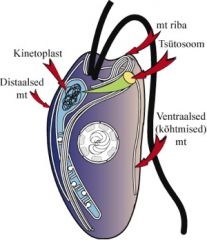
1) long tubular mitochondria containing kinetoplast
2) kinetoplast - disc shaped DNA in minicircles and maxicircles (mitochondrial DNA) located beside but not connect to kinetosome at base of flagella 3) kinetosome - basal body of flagella made of axoneme 4) cytoskeleton 5) paraxial rod 6) undulating membrane 7) glycocalyx 8) glycosomes |
|
|
what is the axoneme?
|
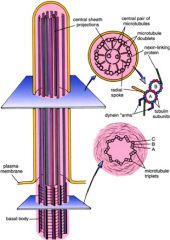
base of flagella that is below the cell membrane. the flagellar core is made of 9 doublets arranged in a circle with 2 singlets in the middle. the kinetosome has 9 triplets in a circle with no singlets int he middle.
|
|
|
What type of lifecycle does a trypanosome have?
|
heteroxenous
live in blood of vertebrates for part of life live in intestines of bloodsucking invertebrates for part of life |
|
|
What are the stages of the trypanosome body formation?
|
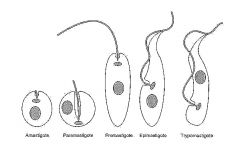
1) amastigote
2) promastigote 3) opisthomastigote 4) epimastigote 5) trypomastigote 6) choanomastigote |
|
|
what is a mastigote?
|
flagellum
|
|
|
what do the prefixes indicate in the trypanosome body forms?
|
position of flagella
A = none Pro = before Epi = above, after Opisto = behind Trypo = borer Choano = collar, funnel |
|
|
amastigote
|
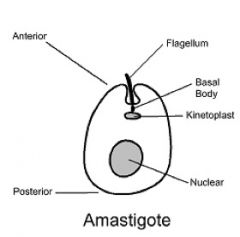
no flagella.
in dividing stage, reproducing form for multiplication of trypanosomes |
|
|
promastigote
|
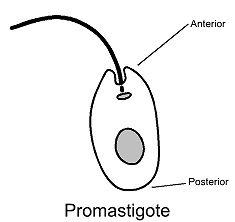
flagella projects out of anterior surface. kinetosome (basal body) and neighboring kinetoplast.
|
|
|
opisthomastigote
|
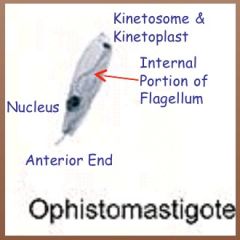
flagella runs internally emerging at anterior end.
kinetosome and kinetoplast are between the nucleus and the posterior end. |
|
|
epimastigote
|
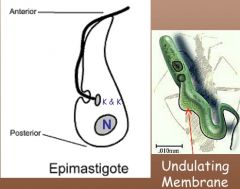
flagella comes from side of organism, but emerges at anterior end. undulating membrane is present. kinetoplast and kinetosome located between nucleus and anterior end of organism.
|
|
|
trypomastigote
|
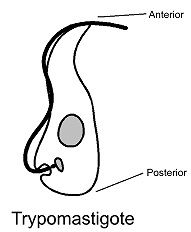
flagella is attached along entire length of body with undulating membrane. kinetosome and kinetoplast are located on posterior end of cell. nucleus is relative anterior.
this is the infective stage for S. American trypanosomiasis and African trypanosomiasis |
|
|
what is the infective stage for S. American trypanosomiasis and African trypanosomiasis
|
tryptomastigote
|
|
|
what are the two major subdivisions of trypanosomes?
|
salivaria - transmistted orally (african)
stercoraria - transmitted through feces (s. american) |
|
|
memorize this table
|
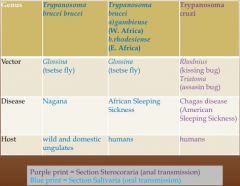
pic
|
|
|
what are the two strands of african trypanosomiasis?
|
1) Nagana - T. brucei brucei
2) African Sleeping sickness - T. brucei gamiense (in W. Africa) and T. brucei rhodensiense (in E. Africa) |
|
|
What is the vector for African Trypanosomiasis?
|
tsetse fly
|
|
|
What is the host for Nagana?
|
wild and domestic grazers
|
|
|
What is the host for T. brucei gambiense?
|
humans
|
|
|
What is the host for T. brucei rhodensiense?
|
E. African dwelling humans
|
|
|
What is the S. American trypanosomiasis disease called?
|
Chagas disease
|
|
|
What is the vector for Chagas disease?
|
Rhodnius (kissing bug) and Triatoma (assassin bug)
|
|
|
What is the organism that causes Chagas disease?
|
T. Cruzi
|
|
|
What is the host for Chagas disease?
|
humans
|
|
|
What is the lifecycle in the intermediate host?
|
in the tsetse fly the following occurs:
1) fly ingests trypomasitgotes going into the crop 2) food (including organism) moves into midgut 3) organisms bore from midgut to salivary glands 4) trypomastigotes transform into epimastigotes and undergo several generations of asexual reproduction 5) epimastigotes become metacyclic trypomastigotes (infective) 6) tsetse fly feeds and infects and poops (because similar actions are going on in midgut and hindcut to become infective) and infects |
|
|
Winterbottom's sign
|
clinical indicator of grossly enlarged posterior cervical lymph nodes indicative of gambiense (W. african) infection
|
|
|
What variation of trypanosomiasis does NOT invade the CNS?
|
rhodesiense
|
|
|
swollen inguinal and axillary lymph nodes
|
clinical indicator of rhodensiense (E. african) infection
|
|
|
Romana sign
|
swelling of soft tissue around the eye that is a clinical indicator of Chagas disease (S. American)
|
|
|
What is the lifecycle of a trypanosome in the definitive host?
|
1) infection as metacyclic trypomastigotes
2) inside cells they transform into amastigotes 3) amastigotes multiply by binary fission in cells of infected tissue 4) cells burst after amastigotes transform into trypomastigotes and then infection goes systemic 5) trypomastigotes infect other tissues and the process continues |
|
|
What is the clinical "first stage" of trypanosome infection?
|
haemolymphatic phase - fever, headaches, joint pains, itching
|
|
|
First stage tx
|
Pentamidine, Suramin (undesired effects)
|
|
|
What is the clinical "second stage" of trypanosome infection?
|
neurological phase - parasite crosses BBB and invades CNS, classic sleeping sickness symptoms appear here
|
|
|
Second stage tx
|
Melarsoprol (many undesired effects), Eflornithine (only effective against gambiense, known as resurrection drug)
|

